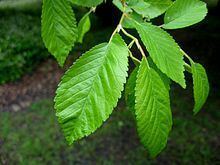Cultivar 'Boissieri' | Origin Iran | |
 | ||
People also search for Ulmus americana 'Nigricans' | ||
The Field Elm cultivar Ulmus minor 'Boissieri' , (Persian: نارون برگریز or نارون گلپشهای), found in Iran and identified by Irina Grudzinskaya as the species U. boissieri in 1977. The tree is endemic to the Zagros forests, with Quercus brantii, Celtis australis, Platanus orientalis, Fraxinus sp., and Cerasus mehaleb. The tree is also found in the provinces of Kermanshah (Qasr-e Shirin, Bisotun) and Kerman.
Contents
Richens however, treated U. boissieri as Ulmus minor.
By the proposed rule that known or suspected clones of U. minor, once cultivated and named, should be treated as cultivars, the tree would be designated U. minor 'Boissieri'.
Description
'Boissieri' is easily distinguished by its small leaves and fruits. The ovate, toothed leaves are 1.5 – 3 cm long, 1.2 – 2 cm broad, typically asymmetric at the base, the upper surfaces glabrous. The leaf veins number from 8 to 12; the petiole 2 – 3 mm long. The perfect apetalous wind-pollinated flowers are minute; the suborbiculate samarae 7 – 9 mm in diameter, with the seed located in the centre.
Pests and diseases
Not known.
Cultivation
An example of 'Boissieri' is grown at the Sir Harold Hillier Gardens, UK.
Synonymy
Etymology
The species is named for Pierre Edmond Boissier (1810-1885), Swiss botanist and explorer who collected many plants in western Asia.
